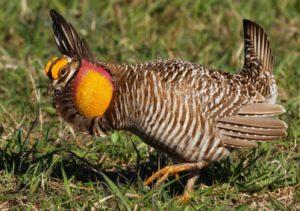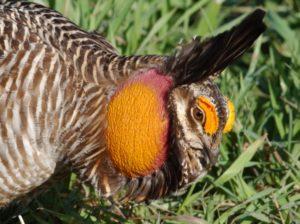Photography courtesy of Lowell Washburn, all rights reserved.
I’m sitting on an isolated prairie hilltop. It’s still pitch dark; more than an hour to go until sunrise. Inside my photo blind, I’m fighting the urge to doze off. I’m located at the edge of an active prairie chicken booming ground [more properly called a lek] hoping to catch a literal glimpse of Iowa’s prairie heritage.
Sharing vast tracts of pristine grasslands with bison, elk, and wolves; prairie chickens were the most abundant gamebird when European settlers first arrived in what we now call Iowa. The species eventually declined and then disappeared altogether as prairies vanished. Beginning in 1987, the DNR launched restoration efforts by releasing live-trapped wild prairie chickens from Kansas and Nebraska onto grasslands in extreme southern Iowa. The birds survived and their descendants have currently reestablished fledgling populations on both sides of the Iowa/Missouri border. The project has become a historic achievement. The very hilltop I currently occupy was originally documented as an active booming ground during the late 1800s.
It took nearly four hours to drive to this prairie, and I’m hoping to view the arrival of the morning’s first bird. Not likely though. I never have succeeded in seeing the first chicken as it sailed in – always too dark. Today will prove to be no exception; and I am startled to the point of jumping when the high volume, maniacal cackling of a male ignites the atmosphere just three feet to my side. It’s a good reminder that this is one wildlife performance that never ever waits for sunrise.
There’s the first hint of light in the east now. Three more males glide in, touch down, and sound their cackling call. Two more arrive and I breathe a sigh of relief. The long drive, lack of sleep, and truck stop coffee are quickly forgotten. The unique and fascinating Spring Ritual of the greater prairie chicken is about to begin. It’s Showtime!!
Somewhere on the dim prairie out front, the first chicken begins his dance. In a cadence too rapid to follow, the bird begins to stomp his feet in blurring succession. The result is an audible tattoo that becomes an intense drum roll. The force of the action causes the chicken to spin like a feathered windup toy.
The best is yet to come. With feet still pounding, the bird bows and begins to pump air into its leathery, orange neck sacs. Once the neck is fully inflated, the prairie song begins. In all creation, it is a sound like no other. A polar opposite from the harsh cackling accompanying the bird’s arrival, the song is eerie, hollow, mournful, and haunting. Once heard, the unique call will be forever etched in your memory. For days after, the sound will be mentally replayed time and again.
The chicken’s initial booming does not go unnoticed by other early arrivals. In a sudden display of jealous rage, a nearby male rushes the dancer. Beak to beak, toe to toe, the birds quickly square off. With hackles raised, the challenge begins. Neither bird is willing to give an inch. Within seconds the cackling resumes and the confrontation escalates. Resembling a pair of barnyard roosters, both males begin leaping into the air; each assaulting its opponent with beak, wing, and claw.
There’s good reason for all the aggression. For greater prairie chickens, spring booming is the very essence of species survival. Although all adult males boom and dance, only the most dominate birds are allowed to occupy the lek’s center stage. This is where the females will eventually come to be courted. Individual hens may only visit the lek one time during the entire breeding season. Competition among males is fierce.
But although daylight is coming rapidly now, the first female has yet to show. And as the sun finally pops above the horizon, the boomers display with increasing vigor. Here, amidst the seeming chaos of cackling, booming, sparing, and retreating; the daily pecking order is reestablished. Dominant males to the center. Younger, more inexperienced birds to the perimeter.
By now, the lek has become an amplified cauldron of sound and activity as each bird does his best to out compete rivals. On a crisp spring morning, the collective booming can be heard for a mile or more. One can only imagine the unfathomable wall of sound that once greeted the dawn as tens of thousands of greater prairie chickens boomed and danced across Iowa’s presettlement prairie landscape.
Suddenly it happens. Quietly and without fanfare, a lone female appears on the hilltop’s skyline. The males acknowledge her presence and the booming escalates to near hysteria. The hen pauses to briefly survey her surroundings. Satisfied that she has become the absolute center of attention, the bird gracefully strides toward the center of the lek.




 Tom Cope
Tom Cope Sue Wilkinson
Sue Wilkinson Susan Judkins Josten
Susan Judkins Josten Rudi Roeslein
Rudi Roeslein Elyssa McFarland
Elyssa McFarland Mark Langgin
Mark Langgin Adam Janke
Adam Janke Joe Henry
Joe Henry Kristin Ashenbrenner
Kristin Ashenbrenner Joe Wilkinson
Joe Wilkinson Dr. Tammy Mildenstein
Dr. Tammy Mildenstein Sean McMahon
Sean McMahon